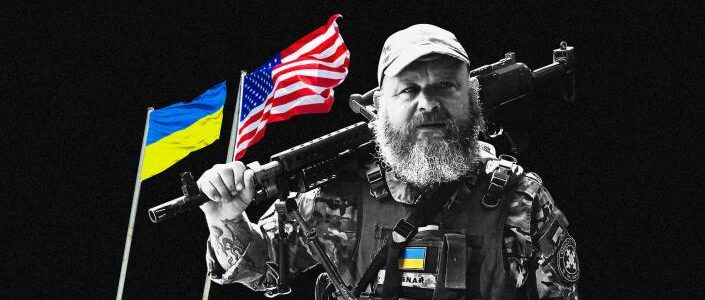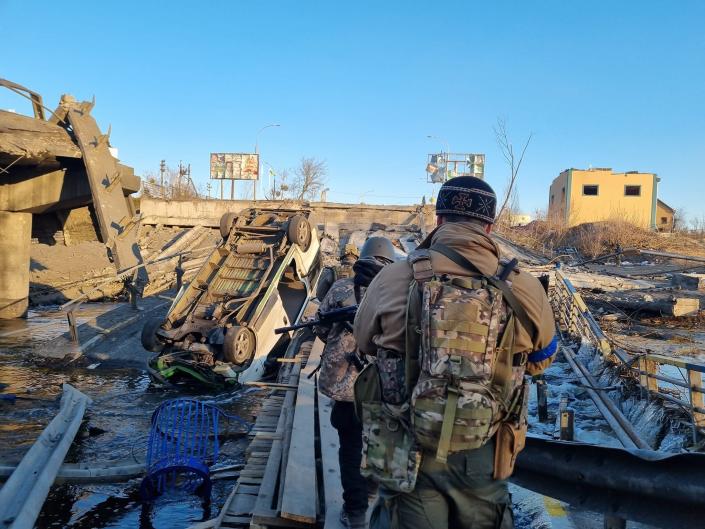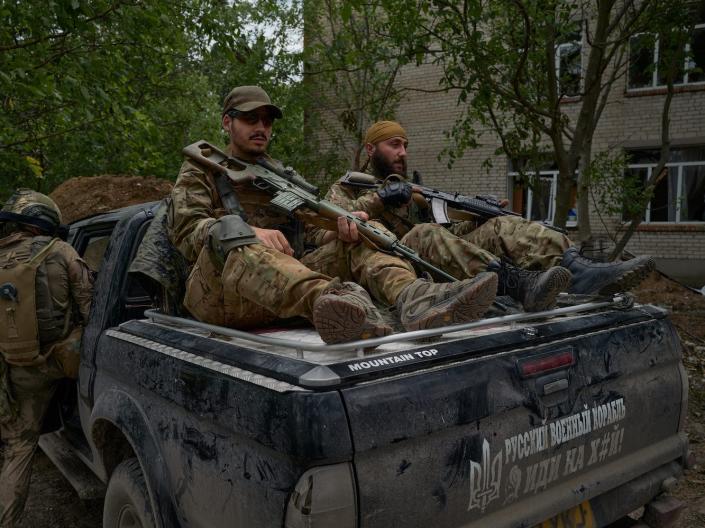
When Maria Lipka called her partner Bryan Young, she was shocked to find that he was already on his way to Ukraine.
A week earlier, the pair, who lived in Tbilisi, Georgia, got into a heated argument after Young said that he wanted to go to Ukraine to defend the country from a full-scale Russian invasion.

The 51-year-old Army veteran from California said he needed to go because it was his duty to protect the free world, Lipka told Insider in a series of interviews.
“I told him that I absolutely don’t understand why he should do it,” she said. “We didn’t speak for a week.”

“I didn’t even have an opportunity just to say goodbye,” she added.
Four months later, he would be dead.
Young traveled to Kyiv, via the Turkish city of Istanbul, in March — roughly a month after Russia’s invasion of Ukraine started on February 24.
The 51-year-old served as a US infantryman between November 1990 and April 2003, before being forced to retire due to injury.
After a lonely two years in lockdown, the news of a war in Ukraine — only a few thousand miles away — gave Young a new sense of purpose.
However, joining the fight against Russia would plunge the former infantryman into a scary new reality.

International defense legion of Ukraine
When Ukrainian President Volodymyr Zelenskyy announced the formation of the international legion on February 27, thousands lined up to volunteer outside Ukrainian embassies worldwide.
Some came with extensive combat experience, having previously fought in countries like Syria, Iraq, or Afghanistan, while others came with nothing more than a burning desire to defend a country in need.
In total, almost 20,000 legionnaires from 52 nations answered the call to arms in the first weeks of the war, Ukraine’s Foreign Minister Dmytro Kuleba said at the time. Around 3,000 of them were US citizens, a top defense official at the Washington DC embassy said in March.
A spokesperson for one branch of the legion, which Young was not part of, told Insider that since the start of the war they have had a “steady influx of people” coming in, but that it has fluctuated depending on the time of year.
“I knew someone was going to die”
After his arrival in Ukraine, Lipka said she received concerning messages from Young, who complained about the lack of organization and equipment in the legion, adding that much was done “like in the old days.”
Young was a part of the 517th battalion of the Ivan Bohun Brigade, which was overseen by the GUR Legion, run by Ukrainian Intelligence.
“The GUR part of the legion is led by Ukrainian officers and usually includes veterans or people who have experience on the battlefield,” Kacper Rekawek, a research fellow for the Center for Research on Extremism at the University of Oslo, told Insider.
Rekawek added that soldiers in this section are often highly skilled and deployed in smaller groups that operate right on the front.
Still, the legion appeared anything but professional.

In June, Young texted Lipka: “It has been a mess where I am, most of the foreign volunteers left. There are only a few of us left.”
In the early hours of July 18, Young and his unit were deployed to Hryhorivka, a village in Ukraine’s eastern Donetsk region that had been under heavy Russian attacks.
They were tasked with clearing out a ravine that Russian soldiers were using to cross a small river, in an effort to slow their advance, according to a situation report published by Politico.
Another American soldier, who was with them at the time and goes by the alias AJ, told Insider that their mission was a disaster from the start, adding that the group had narrowly escaped death multiple times in the days before.
“When we were told to go out again, in my mind I knew someone was going to die,” AJ told Insider.
The GUR did not respond to Insider’s request for comment.

As the men went to find cover in an underground cellar, Russian troops targeted them with artillery fire, AJ said.
The first blast injured Luke “Skywalker” Lusyszyn, another US citizen and medic who had accompanied the battalion that day.
During a brief pause in the firing, Young, and two other soldiers — Emile-Antoine Roy Sirous from Canada and Edvard Selander Patrignani from Sweden — rushed to his side to evacuate him before they too were killed.
Young took a piece of shrapnel to the head, the upper left chest, the legs, and the stomach, a soldier who was with him when he died, told Lipka in messages seen by Insider.
The 51-year-old’s machine gun, which he had named after Lipka, was by his side.
“I know he didn’t feel any pain,” the soldier wrote to Lipka. “I watched him when it happened and I could do nothing, but I know it was painless.”
“It is impossible [to stay safe]. Our commander will get us killed here,” the soldier added.
A preventable death
Lipka told Insider she believes Young’s death was preventable.
Messages sent to her from soldiers in Young’s unit — seen by Insider — reveal that many thought their commander, Ruslan Miroshnichenko, was reckless, and often drunk.
“No one trusts Ruslan, he is a lying piece of shit,” one soldier told Lipka in a text message seen by Insider. “Ruslan has pissed off everyone in the company, especially the Ukrainians. He is a dead man.”
They also claimed that Miroshnichenko was a heavy drinker who often encouraged others to drink before going out on missions. At one point, Young’s battalion destroyed a local bar, and police had to get involved, Lipka says.
When Miroshnichenko called Lipka to discuss funeral arrangements on the phone, the commander sounded drunk, she said.
Lipka also said she never found out about Young’s death from official channels. Instead, she was informed by Young’s daughter, who had seen the news on Facebook.
Miroshnichenko has since been fired from his post as the battalion’s commander, Lipka said.
Insider was unable to confirm his whereabouts, but his LinkedIn profile shows he’s still working for the legion, in a different department.
Poor organization and reckless commanders
Lipka isn’t the only person who has raised questions over the way some foreign fighters were treated in Ukraine, and the dangers they were put in, even while knowing the risks.
Foreign volunteers leaving Ukraine due to poor organization, lack of equipment, and reckless commanders have already made headlines.
In April, Insider talked to two Germans who had gone to Ukraine to volunteer to fight and ended up with a different outfit: the Georgian Legion made up of volunteers mostly from the ex-Soviet country.
They described arriving at barracks that were barren and disorganized and an overall sense of chaos.
“Katastrophe,” Tobias, one of the men, told Insider. “There’s no organization, no organized training. Everyone just wants to kill the Russians.” Neither had any military experience, unlike people like Young.
“My helmet saved my life”
Meanwhile, an investigation published by The Kyiv Independent in August found that some commanders in the GUR were sending men on “suicide missions”, sexually harassing female medics, and threatening soldiers with a gun.
One commander, a Polish ex-criminal named Sasha Kuchynsky, was also a heavy drinker, and sometimes forced soldiers in his troops to help him loot shops, The Kyiv Independent reported.
“A bunch of wannabes, playing with people’s lives,” one soldier, who has since left Ukraine, said of the legion’s leadership.

In a follow-up article, foreign fighters accused some of their commanders of stealing small arms and light weapons that they said went missing from the Legion’s armory rooms, with some saying they witnessed arms being loaded into what they described as civilian SUVs.
Another foreign fighter, who goes by the military alias Mavericks, told Insider he joined the GUR unit in September but decided to leave a month later because of how badly it was run. (Mavericks’ identity is known to Insider).
“My last mission, I lost a colleague,” he said. “The intelligence services told us we needed to be somewhere, so we went and … on our way, we were ambushed.”
Russian troops launched a missile 10 meters away from the unit, killing one Ukrainian soldier and injuring others.
“For two days I couldn’t hear anything,” Mavericks told Insider. “My helmet saved my life.”
Mavericks is back home in Spain and does not plan to return to Ukraine.
Commanders are not always the “creme-de-la creme”
Young wasn’t the last American to die fighting in Ukraine. On November 8, Trent Davis, a 21-year-old US Army veteran from Kansas, was killed on his first mission with the legion, near the southern city of Kherson, according to The Military Times.
Davis was at least the tenth American to die fighting in the conflict, the outlet reported.
The University of Oslo’s Rekawek told Insider that while Ukraine has been “extremely accommodating” to foreign soldiers who came to fight, they had some “teething problems” in the first months of the war.
“The legion first started largely as a PR exercise three days after the war, when Ukraine was in need. So it’s only natural that they had some issues at the beginning,” he said.
Rekawek said that while many of the international volunteers were highly skilled, they are not always the priority.
Also, not all of the commanders appointed by the military were the “creme-de-la-creme” of the crop, Rekawek said, adding that in a case like Young’s, it seems like “a lot of it also came down to bad luck.”
For Young’s partner, this is little consolation.
“How everything was handled, especially after his death, was scandalous,” Lipka told Insider.
Those who survived also bear the scars. Mavericks told Insider he suffers from post-traumatic stress disorder and still mourns the deaths of his comrades.
“I decided to leave because seeing your colleagues die makes you think,” he told Insider.
Despite reports of disarray and confusion, the international legion has grown in strength and importance over the months of the conflict, and has proven to be “tactically and operationally” very handy to the Ukrainian Army, said Rekawek.
“To some extent, this [also] means that the legion is maturing, and is being accepted,” he added.
